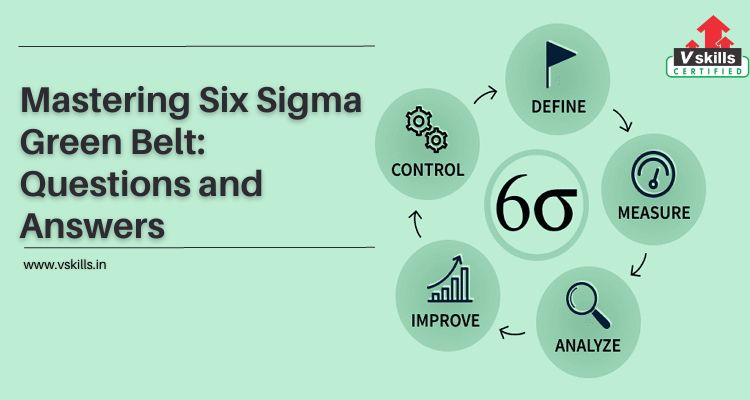The Six Sigma Green Belt certification is a significant achievement in the world of process improvement. This blog will guide you through the essential sections of the Green Belt course, explaining their importance and testing your knowledge with MCQs (Multiple Choice Questions). Let’s dive in!
Section 1: Understanding Six Sigma
This section lays the foundation for your Six Sigma journey by introducing key concepts and principles.
MCQ Questions:
What is the primary goal of Six Sigma?
A) Reducing costs
B) Increasing profits
C) Improving quality
D) Expanding market share
Answer: C) Improving quality
Explanation: Six Sigma primarily aims at enhancing quality and reducing defects.
What does DMAIC stand for in the Six Sigma methodology?
A) Define, Measure, Analyze, Improve, Control
B) Data, Metrics, Analysis, Improvement, Collaboration
C) Direct, Measure, Align, Implement, Coordinate
D) Develop, Manage, Assess, Innovate, Communicate
Answer: A) Define, Measure, Analyze, Improve, Control
Explanation: DMAIC is the core process improvement method in Six Sigma.
Which statistical tool is commonly used in Six Sigma for analyzing process variations?
A) Scatter plot
B) Pareto chart
C) Box and whisker plot
D) Histogram
Answer: D) Histogram
Explanation: A histogram helps visualize the distribution of data.
What is the acceptable defect rate in a Six Sigma process?
A) 3.4 defects per million opportunities (DPMO)
B) 10 defects per thousand opportunities (DPTO)
C) 99% accuracy rate
D) 100% perfection
Answer: A) 3.4 defects per million opportunities (DPMO)
Explanation: Six Sigma strives for an extremely low defect rate.
In which industry did Six Sigma originate?
A) Automotive
B) Healthcare
C) Information Technology
D) Food & Beverage
Answer: A) Automotive
Explanation: Six Sigma was first implemented by Motorola in the automotive sector.
Section 2: Define Phase of Six Sigma Green Belt
This phase sets the project’s direction, scope, and objectives.
MCQ Questions:
What is the primary goal of the Define phase?
A) Collect data
B) Identify root causes
C) Set project goals and scope
D) Implement solutions
Answer: C) Set project goals and scope
Explanation: The Define phase is about defining the project’s purpose and boundaries.
Which tool is commonly used for mapping out process steps and identifying inputs and outputs?
A) Fishbone diagram
B) Value stream map
C) Control chart
D) Scatter plot
Answer: B) Value stream map
Explanation: Value stream maps help visualize and analyze the process.
What document formally authorizes a Six Sigma project?
A) Project charter
B) Process flowchart
C) Pareto chart
D) Ishikawa diagram
Answer: A) Project charter
Explanation: The project charter officially initiates a Six Sigma project.
In the Define phase, what is the key focus when identifying the problem?
A) Identifying solutions
B) Determining root causes
C) Defining the scope
D) Collecting data
Answer: B) Determining root causes
Explanation: Identifying the root causes is crucial to addressing the problem effectively.
What is the primary outcome of the Define phase?
A) A detailed process map
B) A project schedule
C) A list of potential solutions
D) A project charter
Answer: D) A project charter
Explanation: The project charter is a key deliverable of the Define phase.
Section 3: Measure Phase of Six Sigma Green Belt
The Measure phase is about collecting data to understand the current state of the process and establish a baseline for improvement.
MCQ Questions:
What is the primary goal of the Measure phase?
A) Improve the process
B) Define project scope
C) Establish a baseline
D) Identify root causes
Answer: C) Establish a baseline
Explanation: The Measure phase collects data to understand the process’s current state.
Which statistical tool is commonly used in the Measure phase to analyze process capability?
A) Control chart
B) Scatter plot
C) Gantt chart
D) Box and whisker plot
Answer: A) Control chart
Explanation: Control charts monitor process performance and variability.
What is the purpose of a process map in the Measure phase?
A) Identify root causes
B) Define project scope
C) Document the current process
D) Develop a project charter
Answer: C) Document the current process
Explanation: Process maps provide a visual representation of the current process.
Which term is commonly used in the Measure phase to represent the capability of a process to produce defect-free products or services?
A) Sigma level
B) Z-score
C) P-value
D) Confidence interval
Answer: A) Sigma level
Explanation: Sigma level measures process capability in terms of defects.
What does “Gage R&R” stand for in the context of the Measure phase?
A) Gauge reliability and repeatability
B) Great results and recommendations
C) Graphs and recommendations review
D) Gain and reliability reports
Answer: A) Gauge reliability and repeatability
Explanation: Gage R&R assesses the reliability of measurement systems.
Section 4: Analyze Phase of Six Sigma Green Belt
The Analyze phase involves a deep dive into data analysis to uncover root causes and potential improvement opportunities.
MCQ Questions:
What is the primary goal of the Analyze phase?
A) Collect data
B) Define the project scope
C) Identify root causes
D) Set project goals
Answer: C) Identify root causes
Explanation: The Analyze phase focuses on finding the underlying issues affecting the process.
Which statistical tool is commonly used to determine the significance of relationships between variables?
A) Pareto chart
B) Regression analysis
C) Control chart
D) Fishbone diagram
Answer: B) Regression analysis
Explanation: Regression analysis assesses the relationships between variables.
What does the “5 Whys” technique aim to uncover in the Analyze phase?
A) Project scope
B) Root causes
C) Process improvements
D) Control limits
Answer: B) Root causes
Explanation: The “5 Whys” method helps identify underlying causes of issues.
In the Analyze phase, what is the primary focus when evaluating data and conducting experiments?
A) Set project goals
B) Collect more data
C) Identify root causes
D) Develop a project charter
Answer: C) Identify root causes
Explanation: Analyze phase aims to find root causes to address in the Improve phase.
Which term is commonly used to represent the measure of process variation?
A) Sigma level
B) Control chart
C) Fishbone diagram
D) Pareto chart
Answer: B) Control chart
Explanation: Control charts help monitor and analyze process variation.
Section 5: Improve Phase of Six Sigma Green Belt
The Improve phase is where solutions are developed and implemented to address root causes and improve the process.
MCQ Questions:
What is the primary goal of the Improve phase?
A) Collect data
B) Identify root causes
C) Develop and implement solutions
D) Establish a baseline
Answer: C) Develop and implement solutions
Explanation: The Improve phase is about finding and executing solutions to enhance the process.
Which tool helps prioritize potential solutions based on their impact and feasibility?
A) Control chart
B) Regression analysis
C) Fishbone diagram
D) Solution prioritization matrix
Answer: D) Solution prioritization matrix
Explanation: A prioritization matrix helps select the best solutions.
What does the term “Kaizen” mean in the context of the Improve phase?
A) Continuous improvement
B) Immediate results
C) Final project report
D) Process control
Answer: A) Continuous improvement
Explanation: Kaizen focuses on continuous, incremental improvements.
In the Improve phase, what is the primary focus when implementing solutions?
A) Identifying root causes
B) Developing a project charter
C) Measuring process capability
D) Executing changes and improvements
Answer: D) Executing changes and improvements
Explanation: The Improve phase involves putting solutions into practice.
What is the primary outcome of the Improve phase?
A) A finalized project charter
B) A detailed process map
C) Implemented process improvements
D) A list of potential solutions
Answer: C) Implemented process improvements
Explanation: The goal is to apply and validate the chosen solutions.
Section 6: Control Phase of Six Sigma Green Belt
The Control phase is about ensuring that the improvements made in the process are sustained over time.
MCQ Questions:
What is the primary goal of the Control phase?
A) Develop new solutions
B) Monitor and sustain process improvements
C) Identify root causes
D) Establish a project charter
Answer: B) Monitor and sustain process improvements
Explanation: The Control phase aims to maintain the gains achieved.
Which tool is commonly used to monitor process performance and detect variations?
A) Control chart
B) Regression analysis
C) Fishbone diagram
D) Pareto chart
Answer: A) Control chart
Explanation: Control charts track process performance.
What is the purpose of a Control Plan in the Control phase?
A) Develop project goals
B) Maintain project documentation
C) Track process performance and corrective actions
D) Identify root causes
Answer: C) Track process performance and corrective actions
Explanation: Control Plans are used to ensure continued process stability.
In the Control phase, what is the primary focus when assessing process data?
A) Implement new solutions
B) Collect more data
C) Monitor process stability
D) Prioritize potential solutions
Answer: C) Monitor process stability
Explanation: The Control phase aims to maintain stable processes.
What is the key objective of the Control phase?
A) Develop project documentation
B) Maintain and sustain process improvements
C) Implement new solutions
D) Identify root causes
Answer: B) Maintain and sustain process improvements
Explanation: The Control phase’s primary goal is to keep improvements intact.
These sections, along with the MCQs, answers, and explanations, provide a comprehensive overview of the Six Sigma Green Belt course, helping readers grasp the key concepts and principles.




